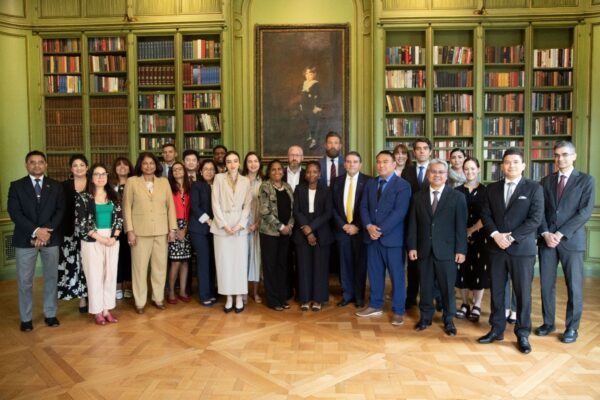Understanding Washington: A Deep Dive into Federalism

How does a country of 50 states, tens of thousands of local jurisdictions, and over 340 million citizens manage to govern itself? That was the central question explored on August 7, 2025, as Meridian brought together a cohort foreign diplomats for a deep dive into the U.S. system of governance.
Guiding the session was Akram Elias, President of Capital Communications Group Inc., who offered a compelling and accessible framework for understanding the complexities of American democracy. Using vivid analogies and real-world anecdotes, Elias unpacked topics such as the defining traits of the constitution, the vertical separation of powers, and the distinct roles of federal and state governments in elections.
These Were the Top Takeaways from the Program
1. Separation of Powers
The Constitution establishes separation of powers among the legislative, executive, and judicial branches. This framework is designed to prevent the concentration of authority by ensuring that no single branch holds unchecked power. Each branch has distinct responsibilities: the legislative branch makes laws, the executive enforces them, and the judiciary interprets them. Additionally, a system of checks and balances enables each branch to limit the actions of the others. For example, the president's veto power, congressional oversight, and judicial review. This structure plays a crucial role in shaping how policy is developed and implemented.
2. State vs. Federal Authority
Rather than a singular centralized system, U.S. governance is structured around federalism: a vertical separation of powers between national, state, and local levels of government. The Constitution allocates certain powers to the federal government, while reserving all others for the states and, by extension, local jurisdictions. This structure creates a dynamic tension between centralized authority and local autonomy that plays out across issues like education, health care, elections, and environmental regulation. Ideologically, debates over “states’ rights” versus “federal oversight” have been a persistent theme in American politics, reflecting deeper ideological divisions over the role and reach of government.
3. The Power of Executive Orders
Executive orders have become a recurring feature of modern U.S. governance, especially amid increasing political polarization and gridlock. The executive powers granted by the Constitution are notably broad and open to interpretation, providing presidents with significant flexibility in how they direct federal agencies and implement policy. Rather than eliminating agencies, presidents may use executive orders to limit or redirect their functions. One example of this strategy was the use of a national emergency declaration to reallocate defense funds for the construction of a border wall, effectively bypassing Congress. This use of executive authority to work around legislative barriers reflects a broader trend within certain conservative policy agendas: leveraging presidential power to reshape the federal government without waiting for congressional action.
4. Political Parties and Their National Agendas
Unlike many parliamentary systems, the U.S. has two major parties, each composed of a network of state-level affiliates. While the national party committees (e.g., the RNC and DNC) play a unifying role, the parties themselves reflect a wide range of regional ideologies and priorities. In recent years, the Republican Party has united more successfully around a unified national agenda—epitomized by efforts like Project 2025, a comprehensive blueprint for reshaping the federal government. This initiative reflects a growing conservative movement to decentralize authority, reduce federal regulation, and empower states. By contrast, many observers note that Democrats have yet to consolidate around a similarly unified policy platform, revealing the complex internal dynamics within each party. Understanding these structures is crucial to grasping how U.S. political agendas are formed, promoted, and implemented.
Project summary
| Understanding Washington: A Deep Dive into Federalism | August 2025 | |
|---|---|
| Countries: | United States |
| Impact Areas: | Governance and Transparency |
| Program Areas: | Diplomatic Engagement |